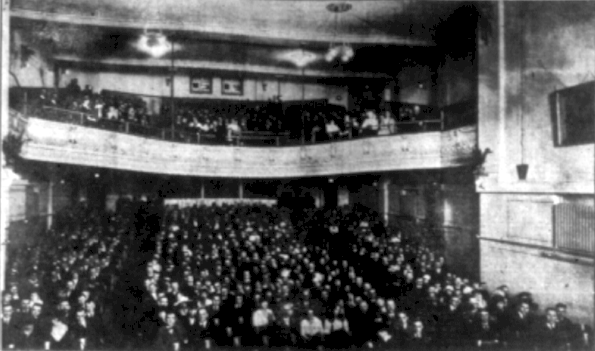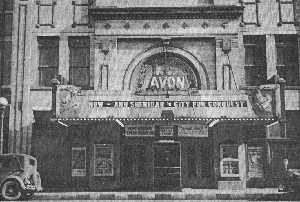HISTORY OF THE AVON
The Avon Theater officially opened in 1916, just a few short weeks after the Lincoln Theater opened its doors for the first time. The Avon was a unique place in that it was a large, grand theater, on the scale of the Empress Theater or the Lincoln Theater, but yet the Avon had been constructed for showing moving pictures only. There would be some live entertainment and music, but this theater was a folly to many…. they believed that moving pictures were simply a passing fad and would never last.
Over the years, the American film industry has defied the odds and has endured. Fortunately, even after a number of near disasters, the same can be said for the Avon. After a bright beginning and a long run of success, the theater was closed down and abandoned and most feared that it would be lost. For several years, it was said the Avon would soon join most of the other old theaters in Decatur and would be destroyed. But yet somehow, the theater still remains today. Thanks to public interest, creative planning, innovative thinking and a lot of hard work, the Avon is once again open and thriving in downtown Decatur.
The Avon opened on November 28, 1916 and was decorated with original artwork by Mrs. CO Knapp of Bement, a local artist, making the Avon one of the most expensively decorated moving picture houses in the entire country. The ornaments and decor inside of the theater were said to even rival the twin, seven-foot-tall monuments on the posts outside of the building. A third statue was located just above the curtains. It was of a woman, reclining in the nude, and holding a wreath outward toward the audience. On a parallel with this figure, circling the entire auditorium, were base-relief casts of women’s heads. They were only matched by the lion’s heads that circle the theater below them, the eyes of those creatures glowing with brilliant light.
 THE STATUE OF THE WOMAN THAT ORIGINALLY WAS LOCATED ABOVE THE SCREEN, BUT NOW IS HIDDEN BEHIND THE CURRENT ONE
THE STATUE OF THE WOMAN THAT ORIGINALLY WAS LOCATED ABOVE THE SCREEN, BUT NOW IS HIDDEN BEHIND THE CURRENT ONE
The artwork and the decor were not the only things that make this theater special. The screen was the largest and best designed in the city. Dozens of hours were spent whitewashing the rear wall of the theater in an attempt to make it as smooth and as clean as possible. The film projectors were the best models available and an orchestra was scheduled to appear on a regular basis to provide musical accompaniment for the films. In addition, the theater was also equipped with a giant pipe organ that was electrically controlled. It was located in three different parts of the building so that it would be acoustically correct for the entire audience.
The opening-night audience was treated to a few words from Decatur’s mayor, Dan Dineen, who expressed his appreciation for the theater. He stated that it is “unquestionably the handsomest and largest in the state of Illinois devoted exclusively to moving pictures.” He also boasted that, thanks to new businesses like the Avon Theater opening up, Decatur could finally take its place in the ranks of real cities.
The Avon became known as one of the most beautiful theaters in the Midwest and prospered for many years. It would not hold onto its crown though and the years were not kind to the place. After some extensive remodeling that was done in the 1950’s, the theater never again had the elegance of its early days. For several years, the building was closed and there was thought to be no chance that the Avon will ever welcome theater patrons through its doors again. The lobby and auditorium fell into poor condition and the last attempts to restore, or at least to salvage the theater’s dignity, met with indifference and a lack of enthusiasm…. until recently, when new occupants began restoring the old building, stirring up years of dust.
The theater saw a decline in revenue and business during the 1980’s, becoming the last theater to operate in the downtown area. By this time, audiences were mainly ignoring the Avon in favor of the new multiplex theaters on the north side of town. In 1985, the theater converted to showing second-run movies but that was not enough to keep the place open. It finally closed down in April 1986. The last of the independent theaters in Decatur had now ceased to exist.
After that, the theater was empty for many years, although there was an attempt to bring it back to life in 1989 when it was used for several live music shows. The problem was that the theater had never really been designed for live entertainment and the shows met with only short-lived success.
The Avon opened again in 1993 as a second and third-run bargain house and while the initial response was good, business soon died out. It remained open this time for a little over a year and then closed down for another six years. In 1999, the Avon opened once again, this time as an independent and art film theater, showing alternative films and limited release features that in the past would have never been seen in Decatur. Finally, the Avon again began to thrive and a new audience was reached. It appears the theater has finally managed to restore itself to the status it once had and hopefully the residents of Decatur will help to keep it there.
I spoke to my friend, theater owner and operator, Skip Huston, and I asked him why he believed the Avon was once again successful and why it seemed to be appealing to such a wide audience again. “I feel like the theater really fills a niche,” he explained, “and it’s one that has been in need of being filled since theater in Decatur began. Our goal is to show films that are not mainstream features. They are not usually blockbusters but what I think of as art and alternative films. I really like being able to bring them to the city… and apparently, the city of Decatur likes having them here.”
If you should have the good fortune to visit the Avon, you will find the trip to be an interesting one… if you know where to look. Much of the decor that was described earlier in this section is gone now. The lion’s heads have vanished with time, as has most of the ornate plasterwork and all of the original art. Remodeling was carried out in both the 1950’s and then two decades later, in the 1970’s. At that time, most of the reminders of yesterday were hidden or simply destroyed.
The only place in the theater that can give you an indication of how things once looked is behind the screen. In 1953, a new widescreen was installed in the Avon to show Panavision and 3-D films. In fact, the very first widescreen film that came to Decatur, THE ROBE, was shown at the Avon. When this work was completed, the screen was moved about ten yards from the back wall of the theater. The area behind the screen now acts as sort of a “time capsule” of how the theater looked in the days when it first opened.
Time has taken its toll here too but much of the original paint and plaster still remains, along with the decorator pieces that were added to the woodwork. The area behind the screen is the original, narrow stage of the theater and the place where the sound system and the antiquated air-conditioning unit is located. Directly above the heads of any visitors is the relief of the nude, reclining woman that once looked out over every audience that came to the theater. She is in fairly poor condition now, but the artwork and the design that went into her creation is rarely seen today.
Just below her, and only inches above the air conditioning duct that was added much later, is another example of the theater’s artwork. There, mounted onto the wood and plaster wall, is a pair of angels that are holding a metal shield between them. There is a letter “A” ornately inscribed on the shield.
In addition, most of the original painted stencils remain on the walls and ceiling here as well. The small dressing rooms also remain on both sides of the original stage. They were once used by the performers and celebrities who came to entertain and announce the films that played here. There is detailed wood decoration around the doorways and also around the doorways that led upstairs to the private seating boxes. These boxes were once located directly above the pipe organ mechanisms and they offered an unobstructed view of the original screen. Other than these lonely doorways, no trace of the boxes can be found today.

ONE OF THE ORNATE DOORWAYS BEHIND THE SCREEN, WHICH LED TO DRESSING ROOMS AND THE PRIVATE SEATING BOXES



